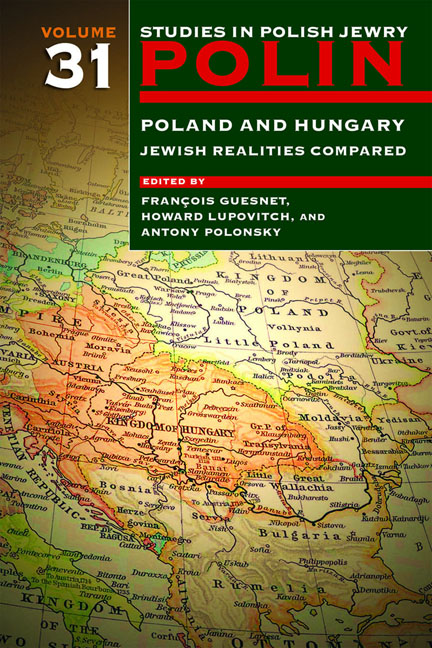Book contents
- Frontmatter
- Dedication
- Editors and Advisers
- Preface
- Polin
- Polin: Studies in Polish Jewry
- Contents
- Note on Place Names
- Note on Transliteration
- Part I POLAND AND HUNGARY: JEWISH REALITIES COMPARED
- JEWISH ACCULTURATION AND INTEGRATION
- JEWISH RELIGIOUS LIFE
- JEWS IN POPULAR CULTURE
- THE INTERWAR YEARS
- THE HOLOCAUST AND ITS AFTERMATH
- PERSONAL REFLECTIONS
- Part II NEW VIEWS
- Part III OBITUARIES
- Notes on the Contributors
- Index
Jewish Women in Poland and Hungary
- Frontmatter
- Dedication
- Editors and Advisers
- Preface
- Polin
- Polin: Studies in Polish Jewry
- Contents
- Note on Place Names
- Note on Transliteration
- Part I POLAND AND HUNGARY: JEWISH REALITIES COMPARED
- JEWISH ACCULTURATION AND INTEGRATION
- JEWISH RELIGIOUS LIFE
- JEWS IN POPULAR CULTURE
- THE INTERWAR YEARS
- THE HOLOCAUST AND ITS AFTERMATH
- PERSONAL REFLECTIONS
- Part II NEW VIEWS
- Part III OBITUARIES
- Notes on the Contributors
- Index
Summary
DEPENDING on their religious allegiance and their place of residence (urban or rural), the everyday life of Jewish women in Hungary followed roughly one of two models: either the German or the eastern European one. To compare how Jewish women fared in Hungarian and Polish lands—since a gendered history of Hungarian Jews comparable to those which exist for Polish Jews is unavailable and an extensive history of Hungarian women also remains to be written—I will follow in Moshe Rosman's and Gershon Bacon's footsteps. After having surveyed some sources similar to those they used and highlighted some resemblances and differences, this chapter takes the narratives of twenty-four Polish and twenty-four Hungarian women as the base for a more detailed comparison of their lives from the end of the First World War to the early years of the twenty-first century.
JEWISH WOMEN IN HUNGARY PRIOR TO THE SECOND WORLD WAR
In the last 200 years the Jewish population of Hungary (over 900,000 at its highest in 1910), was deeply divided by several—communal, cultural, regional—schisms, but above all, by the religious division brought about following emancipation. Between the first Jewish Congress (1868–9) and the Holocaust, which nearly put an end to the very existence of Jewish life in the Hungarian countryside, substantial differences prevailed in religiosity as well as in day-to-day routine among the different religious groupings of Hungarian Jewish society. The more modernized Neolog, the mostly Moravian and Viennese-connected western Orthodox, and the hasidic Galician eastern Orthodox communities were characterized by very distinct cultural and religious behaviours. These differences were closely connected to the geographical origin of several waves of Jewish immigration: by the beginning of the twentieth century descendants of immigrants from German Austria made up 15 per cent; from Moravia–Bohemia, 25 per cent; and from Poland and Galicia, 50 per cent of the Jewish population in Hungary. Still, not infrequently, surnames remain the only indicators of these migrations: they were the last reminders of completely forgotten origins (as in case of my great-grandmother Katalin Pollák).
- Type
- Chapter
- Information
- Polin: Studies in Polish Jewry Volume 31Poland and Hungary: Jewish Realities Compared, pp. 143 - 158Publisher: Liverpool University PressPrint publication year: 2018



